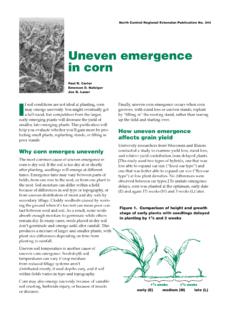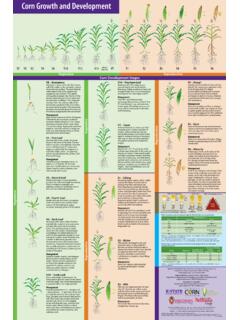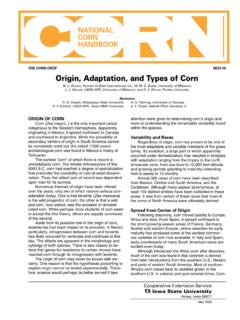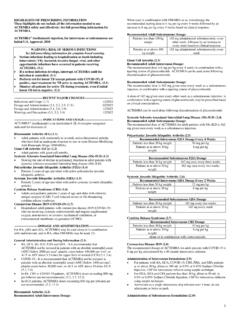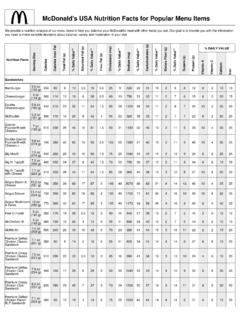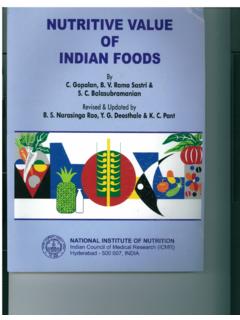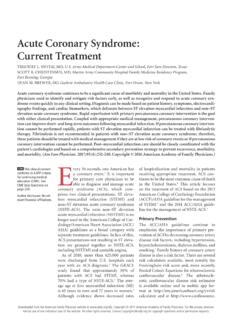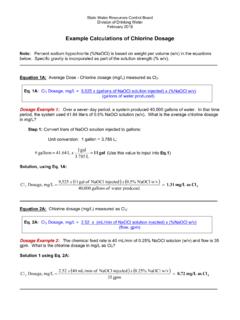Transcription of Soil Calcium to Magnesium Ratios—Should You Be …
1 While some sales people and scientists have claimed that there is an ideal soil Calcium to Magnesium ratio (Ca:Mg), and that Wisconsin soils contain too much Magnesium for the amount of Calcium present, research in Wisconsin shows this is not true. The Ca:Mg ratio seldom limits plant growth if soil pH is maintained in the good growing range. Thus, we do not recommend applying Calcium materials to soils simply to increase the Ca:Mg is a Ca:Mg ratio?The Calcium to Magnesium ratio is merely a statement of the relative proportions of available Calcium and Magnesium in the soil .
2 It does not give any information about the actual levels of these example, one soil may have exchangeable Calcium and Magnesium levels of 250 and 50 lb/a, respectively, while another soil may have 2,500 and 500 lb/a of exchangeable Calcium and Magnesium . Both have identical Ca:Mg ratios. However, in the first soil mentioned, both nutrients would be marginally low, and in the second soil , they would be present in adequate :Mg ratios also can be misleading in other ways. For example, a low Ca:Mg ratio reflects one of two possible situations: (1) a soil with low exchangeable Calcium and normal Magnesium , or (2) a soil with normal exchangeable Calcium and high Magnesium .
3 It is impossible to distinguish between these two cases using only a ratio. On the other hand, a high Ca:Mg ratio means there is either (1) too little Magnesium relative to Calcium , or (2) Calcium is excessive relative to Ca:Mg concept The idea that a proper Ca:Mg balance is necessary for good plant growth was conceived by New Jersey researchers in 1901: They recommended a total Ca:Mg ratio of about 5:4. However, soil scientists soon recognized that total element analysis is difficult and not necessarily a good measure of the amount of nutrients available to plants.
4 Subsequently, soil scientists began searching for other methods of measuring nutrient the years, testing for exchangeable Calcium and Magnesium has been found to give reasonably good estimates of the amounts of these elements potentially available to plants. Exchangeable Calcium and Magnesium are attracted to negatively charged sites on clay and organic matter in soil where they are not easily leached from the soil but are available to plants. Currently, almost all soil testing laboratories in the United States use the test for exchangeable Calcium and Magnesium .
5 However, this test may be interpreted differently depending on the research upon which it is example, the New Jersey study determined that the ideal alfalfa soil should have 65% of the cation exchange sites occupied by Calcium , 10% by Magnesium , 5% by potassium and 20% by hydrogen. However, further research has shown that these percentages can vary considerably without affecting crop yields. For example, the percent of exchangeable sites occupied by Calcium can range from 55 to 75% without any soil Calcium to Magnesium ratios Should you be concerned?
6 E. E. Schulte and KellingA2986yield reduction, as long as Magnesium and potassium are present in adequate work in several states suggests that the optimum percent saturation of exchange sites with a given cation is not constant but depends on the cation exchange capacity of the soil . Sandy or coarse-textured soils have a low cation exchange capacity and require a higher percent potassium saturation. On the other hand, medium- or fine-textured soils have a high cation exchange capacity and do not require as high a percent of potassium mineralogy of the soil is also an important factor in determining optimum percent saturation of exchange sites with a given cation.
7 Some soils, such as the reddish soils of eastern and northern Wisconsin, can release significant amounts of nonexchangeable potassium. The optimum percent potassium saturation is lower for these soils than soils having little nonexchangeable of these differences in the cation exchange capacity of soils and soil mineralogy, the concepts of cation ratio and percent base saturation cannot be applied to all soils. In addition, research on other states soils does not necessarily apply to Wisconsin to an early survey, Calcium and Magnesium levels in Wisconsin soils vary considerably.
8 Calcium content ranged from 50 lb exchangeable Calcium /a (in Boone loamy sand (Monroe County) with a Ca:Mg ratio of 1:1 to 18,000 lb/a in a Westerville silt loam (Richland County) with a ratio of Magnesium ranged from 26 lb/a in an Ottawa loamy sand (Juneau County) with a Ca:Mg ratio of :1 to 8,340 lb/a Magnesium in a Pella silt loam (Kenosha County) with a ratio of :1. This latter sample was the only sample of 668 taken in Wisconsin where the Ca:Mg ratio was less than 1:1. At other sites, Pella silt loam had Ca:Mg ratios between 3:1 and 4 1 shows that most of the common soil types in the state have Ca:Mg ratios that range from 1:1 to 8 recently, test results from Wisconsin soil testing laboratories (January 1977 to December 1981) found the average levels of exchangeable Calcium and Magnesium to be 2,830 and 745 lb/a, respectively.)
9 This gives an average Ca:Mg ratio of :1. Less than 1% of the 34,755 samples analyzed for Calcium had less than 250 lb Ca/a, and contained more than 6,000 lb/a. Only of these samples contained less than 25 lb Mg/a and had more than 1,600 researchSome experimental work in Wisconsin varied the Ca:Mg ratio by adding gypsum (CaSO4) and/or Epsom salts (MgSO4) to two soils, Theresa silt loam (pH ) and Plainfield loamy sand (pH ). Phosphorus, potassium and sulfur were maintained at optimal levels throughout the experiment.
10 Corn and alfalfa were grown as indicator 2 shows the changes in alfalfa yield resulting from varying the Ca:Mg ratio. The results for corn, which yielded 100 and 140 bu/a in 1974 and 1975, respectively, are essentially the same as those for to this study, varying the Ca:Mg ratio from slightly above 2 to more than 8 did not significantly affect yield on either soil . Adding Calcium and Magnesium to the soil did change the percent Calcium saturation of the exchange sites from anywhere between 32 to 68% and the Magnesium saturation from 35 to 12% (Table 2).
